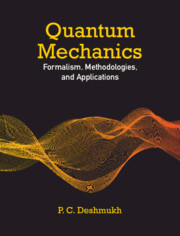Book contents
- Frontmatter
- Dedication
- Contents
- List of Figures
- Foreword
- Preface
- 1 Description of a Physical System
- 2 Path Integral Formulation of Quantum Mechanics
- 3 Probability Tangles and Eigenstates of One-dimensional Potentials
- 4 Angular Momentum
- 5 The Non-relativistic Hydrogen Atom
- 6 Approximation Methods
- 7 The Relativistic Hydrogen Atom
- 8 Quantum Mechanics of Spectral Transitions
- 9 The Many-Electron Atom
- 10 Quantum Collisions
- 11 Introduction to Quantum Information and Quantum Computing
- Appendix A Symmetry of the Hamiltonian
- Appendix B Schrödinger, Heisenberg, and Dirac “Pictures” of Quantum Dynamics
- Appendix C Spherical Harmonics
- Appendix D Occupation Number Formalism Second Quantization
- Appendix E Electron Structure Studies with Qubits
- Index
8 - Quantum Mechanics of Spectral Transitions
Published online by Cambridge University Press: 14 September 2023
- Frontmatter
- Dedication
- Contents
- List of Figures
- Foreword
- Preface
- 1 Description of a Physical System
- 2 Path Integral Formulation of Quantum Mechanics
- 3 Probability Tangles and Eigenstates of One-dimensional Potentials
- 4 Angular Momentum
- 5 The Non-relativistic Hydrogen Atom
- 6 Approximation Methods
- 7 The Relativistic Hydrogen Atom
- 8 Quantum Mechanics of Spectral Transitions
- 9 The Many-Electron Atom
- 10 Quantum Collisions
- 11 Introduction to Quantum Information and Quantum Computing
- Appendix A Symmetry of the Hamiltonian
- Appendix B Schrödinger, Heisenberg, and Dirac “Pictures” of Quantum Dynamics
- Appendix C Spherical Harmonics
- Appendix D Occupation Number Formalism Second Quantization
- Appendix E Electron Structure Studies with Qubits
- Index
Summary
The GMRT (Giant Metrewave Radio Telescope) is an array of thirty fully steerable parabolic radio telescopes having a diameter of 45 meters for radio astronomical research at meter wavelengths. It is an extremely advanced facility set up by the National Centre for Radio Astrophysics at Khodad (near Pune, India).
Theories of the formation of structure in the Big-Bang Universe predict the presence of proto galaxies or proto clusters of galaxies made up of clouds of neutral hydrogen gas before their gravitational condensation into galaxies. It should in principle be possible to detect these through the well-known radio line emitted by neutral hydrogen at a frequency of 1420 MHz. (see Fig. 7.4 in Chapter 7). The line is, however, expected to be very weak and red-shifted to meter wavelengths because of the expansion of the universe between emission, billions of years ago, and detection at the present epoch. Visit: http://www.ncra.tifr.res.in/ncra/gmrt/ about-gmrt/goals-of-gmrt (courtesy: NCRA , TIFR, India). (downloaded on 26 March 2023).
In the previous seven chapters, we have introduced the barebones of quantum mechanics. The methodology we reviewed equips us to study the physical universe we live in. Spectroscopy is a powerful experimental technique used to investigate matter. Basically, spectroscopy investigates a target system through its interaction with a probe, which can be electromagnetic radiation, or elementary or composite particles, or their combination. Our prototype of the target system is an atom. Atomic spectroscopy, or more generally atomic physics and quantum physics developed synchronously. These disciplines continue to interpenetrate each other to jointly push the frontiers of science, engineering, and technology.
8.1 Spectroscopic Oscillator Strengths
Spectroscopy literature is embellished by terminology from classical, semi-classical, and quantum-mechanical models. An all too pervasive term employed in the description of spectral transitions is the oscillator strength [1, 2]. It has its origins in the earliest explanatory models that used classical mechanics. The phenomenology pertaining to the spectroscopic oscillator strength is now comprehensively integrated into the fully quantum mechanical scheme. It is insightful to track the metamorphosis of the term oscillator strength from its earliest avatar in semi-classical physics to its current usage within the quantum models.
Let us consider a spectral transition in an atom which results from the absorption of electromagnetic energy. It is natural to inquire how much power is pumped by the electric field into the atomic system.
- Type
- Chapter
- Information
- Quantum MechanicsFormalism, Methodologies, and Applications, pp. 360 - 410Publisher: Cambridge University PressPrint publication year: 2024



